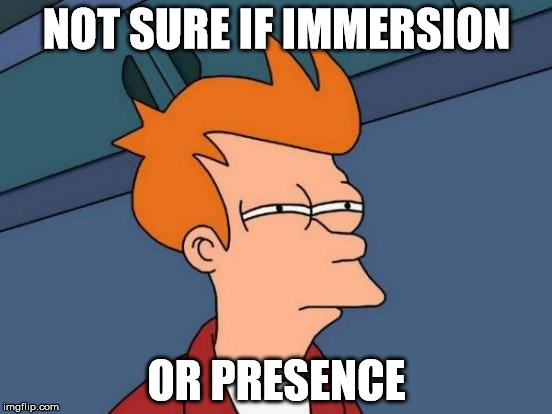The difference between presence and immersion
Today I was talking with my friend Andrea about our ImmotionRoom system and he asked me: “but your virtual reality system increases presence or immersion?” and I was like “eeeh…uhm… aren’t they the same thing?”. Of course not, so Andrea started to introduce me the difference between this two terms. After his explanation, my mind was completely blown.

Thanks to him, I just documented a bit and so now I’m going to tell you the difference between this two terms, so you won’t do the same error while speaking to another Andrea. It could also be a great pick-up line: “Hello girl, do you want to talk with me about the difference between immersion and presence?” (of course not, but at least you tried)
So, in virtual reality:
- Immersion is the ability of the virtual reality system of actually tricking you in feeling that you’re somewhere else. I’m talking about sensorial information that gives brain the impression that you’re in another place: visual informations, audio, haptic feedback and so on. Immersion is something very technical: it regards how good are all the virtual reality devices you’re employing. So, using an Oculus DK1 gives you less immersion that using an Oculus CV1, due to worse resolution, FOV and so on. With perfect immersion, you have in virtual reality exactly the same sensorial informations of the real world: your brain can’t tell the difference between virtual and real.
- Presence is how you’re really engaged and feel yourself inside the virtual world. Presence does regard features of the virtual reality experience that the user is living: if the story is compelling, he will be completely absorbed by it; if the world offers social interactions and other avatars interact in a natural way with the user, it will seem more real; if interaction with the virtual world is easy and natural, it’s great; and so on. Presence indicates how much the user feels engaged with the virtual reality experience, how much he feels that one as a true experience he’s living.

The two concepts are obviously not that separated and there is a grey area between the two. Furthermore, immersion is important to offer presence: if the virtual world is great, but you’re living it through a headset of the ‘80s, you can’t feel really there, so presence is ruined.
But this is not always true: if the story is really compelling, with great characters and involves you and you remain there long enough that your brain gets used to graphics, well, you could feel presence anyway, because your brain will feel like really living in that world. Andrea told me that you could feel presence even without having any immersion: think about D&D or other role games: there are people actually feeling that they are paladins level 9000 in a fantasy world, while there is no sensorial information confirming that scenario.
There are lots of different interpretations about these two terms (different people having different opinions on this two terms, on if immersion is necessary to presence, on different kinds of immersion and presence, etc…), but the main concept I’ve expressed holds. Immersion is how good are the sensorial informations; presence is how much you do really feel inside the virtual world. Immersion is more objective; presence is more subjective.
And that’s it, hope to have clarified this to you… so from now on, please don’t confuse these terms anymore, so we will make all Andreas of the world happy! 🙂
Disclaimer: this blog contains advertisement and affiliate links to sustain itself. If you click on an affiliate link, I'll be very happy because I'll earn a small commission on your purchase. You can find my boring full disclosure here.




A very smart guy on reddit (https://www.reddit.com/user/LegoKnockingShop) answered with this, that is more useful than my original article… have a nice reading time!
—
These are some fun definitions! Of course, Immersion and Presence aren’t new terms, and their definitions have been extensively discussed and debated over the last 30 years.
This is one of many academic breakdowns you can find by googling, but it’s a fairly well favoured one.
I do a lot of work with VR developers, and we inevitably need to expand the terms ‘presence’ and ‘immersion’ out into a more usable lexicon. Like ‘Gameplay’, they’re really wide reaching terms that need further sub classification to be at all useful once you start looking into the nitty gritty of different types and occurrences.
For those interested, this is what we use, will try my best to give concise explanations! –
Spatial Presence
Spatial Presence describes the feeling that media contents are ‘Real’. This applies to books, movies and other media as well as VR, and describes both the sense of being physically present in such a mediated world, and the extent to which a user feels present in the mediated Virtual Environment (VE) rather than in the immediate physical environment. Spatial Presence requires both attention allocation (i.e. the game provides enough distraction) and the establishment of a mental model of the mediated environment and actions within it (i.e. an Expectation Model of how this world and the things in it will work) to be prerequisite conditions for a sense of Spatial Presence to occur.
Cognitive Presence
Cognitive presence is the mind element of Presence – when you feel presence when playing a game, watching a movie, listening to a spoken tale, reading a book, or enjoying VR – where your mind takes you to another world, this is commonly referred to as Cognitive presence. This aspect of presence is the part that exists in your brain independent of any sensory inputs – it may help to think of it as the ‘inner you’ inside your mind, or the bit of your brain that can think about thinking.
Perceptive Presence
Perceptive Presence can be thought of as the elements of Presence which fool your senses in a realistic way. These are the inputs from our own bodies that reinforce the sense of Presence. This includes vision, sound, touch, smell, taste, and proprioception (which is the sense of the relative spatial position of your body parts, and the strength of effort used to move them). Human perception of the world around us is reliant on all sorts of assumptions and simplifications made by the brain to speed up the processing of the overwhelming amount of input data, and to make the perceptive process quicker and more flexible. Understanding where these assumptions come into play is a very useful tool for VR designers, as it allows scope to create perceptive illusions that can trick the mind, inducing a believable sense of perceptive presence in users.
Body Presence
Body Presence can be thought of as the feeling that your virtual body is actually your own. Any instances where the player feels contact points with real life objects and believes they are actually feeling the sensation of touching a virtual object instead (e.g. holding a move controller but believing it’s a sword), or where players believe the movement of their avatar form is directly linked to their own motor inputs (e.g. accurate precise hand tracking) are examples of interactions that can provide a high degree of Body presence.
Emotional Presence
The emotional power of VR can be extremely powerful compared with traditional media, thanks to the sense that you are actually present in the scene. Presence is commonly regarded as a necessary mediator that enables real emotions to be activated by a virtual environment. Emotional presence can be thought of as any emotional response (fear, anxiety, joy, loss, sadness etc.) that occurs as a natural response to stimuli and events in the Virtual Environment and that cannot be overridden mentally. It is a natural and genuine emotional connection and reaction to virtual stimuli and events, as if they were real.
First Order Presence
All our experiences of the real, physical world are mediated by the human senses and our complex perceptual processes. This experience is our natural, ‘normal’ way our senses perceive the physical world day-to-day, without mediation by any technology, and is often conveniently described as First Order Presence. (Technically this is a misnomer, since ‘Presence’ requires mediation by human-made technology – First Order Presence describes our sense of being present, physically and mentally, in the real world; ‘Presence’ in all other usage here refers to the experience of believing you are in one place while physically situated in another).
Of course, this isn’t exhaustive, but it covers all the areas we tend to work in, and helps with more in-depth discussions about the Presence state, how to achieve it, and how to maintain / manage it.
Hope this is of interest to some!
—
I reach here while reading the last article and seems I missed this one at the time! It’s really interesting the difference between Immersion and Presence. And honestly I learned it just a few months ago while doing an online VR course by the University of London. So just wanted to add another interesting thing Mel Slater, a veteran researcher in VR from that University (he really knows a bunch about this kind of psychological things of VR!), says about Presence. Basically he further subdivides Presence in three main illusions: place illusion (PI), plausibility illusion (Psi) and embodiment illusion (EI).
– Place illusion is the feeling that you are in another place even when you know that you are inside a room in the real world. It’s given by how much of that virtual world matches the so called sensorimotor contigencies of the user in the real world (implicit rules we use to perceive the world across all of our senses). For example, if you move your head and the world moves accordingly because of head tracking, or if you touch something and you feel it in your hands, the PI will be enhanced,
– Plausibility illusion is the feeling that what you are experiencing feels real and feels as it’s really happening, and it’s more related to the user expectations. For example, if you are talking with a virtual character and he’s gazing on you, or if I talk back to him and he responds accordingly, all those are things that will enhance de Psi.
– Finally, Embodiment illusion has to do with the feeling that your inhabiting another body, which reacts properly to your movements. That’s why 360 videos are not good at creating this illusion, but positional tracked VR is (even more with full body tracking!).
And all this illusions together is what he calls Presence. Quite theoretical and complicated stuff but pretty interesting! Btw here’s the whole paper: http://rstb.royalsocietypublishing.org/content/364/1535/3549
I’ve read about this stuff somewhere else, too (maybe it was an interview by Voice of VR)… it’s really interesting! Your comment is super-informative as always… I hope that all people that will read my article will scroll down to the comment section to read it!